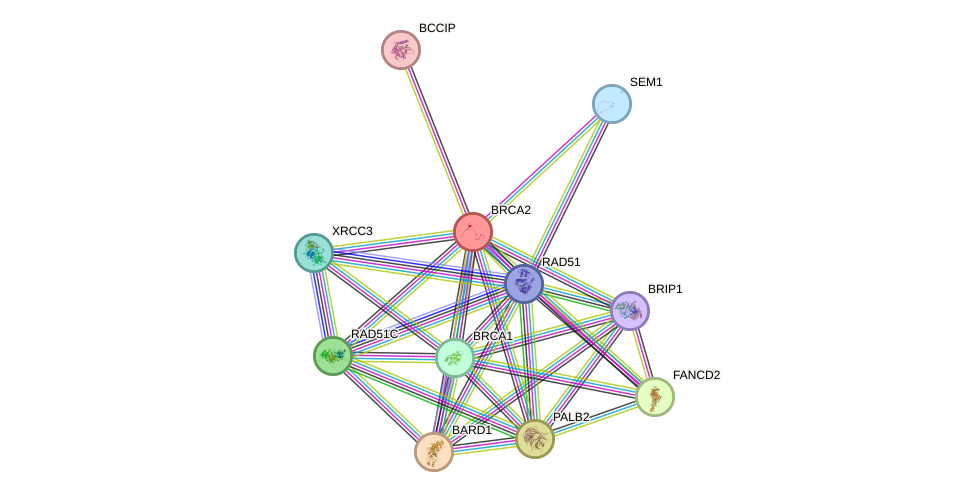GenAge entry for BRCA2 (Homo sapiens)
Gene name (HAGRID: 79)
- HGNC symbol
- BRCA2
- Aliases
- FAD; FAD1; BRCC2; XRCC11; FANCD1; FACD; FANCD
- Common name
- breast cancer 2, early onset
Potential relevance to the human ageing process
- Main reason for selection
- Entry selected based on evidence linking the gene product to a pathway or mechanism linked to ageing
- Description
BRCA2 is an important protein in cellular responses to DNA damage and may be directly involved in DNA repair. Mice deficient for BRCA2 have a reduced lifespan, though it is not clear whether they age faster [475]. Cells from human patients with mutations in BRCA2 exhibited reduced rates of DNA repair and elevated levels of protein ADP-ribosylation. These patients demonstrate motor apraxia, axonal neuropathy, and progressive cerebellar ataxia. Deletion of PARP1 in BRCA2-null mice partially reversed some of these effects [4487]. Although BRCA2's role in cancer is clear [1676], elucidating its role in human ageing will require additional studies.
Cytogenetic information
- Cytogenetic band
- 13q12.3
- Location
- 32,315,480 bp to 32,399,672 bp
- Orientation
- Plus strand
Protein information
- Gene Ontology
-
Process: GO:0000722; telomere maintenance via recombination
GO:0000724; double-strand break repair via homologous recombination
GO:0000731; DNA synthesis involved in DNA repair
GO:0000732; strand displacement
GO:0000910; cytokinesis
GO:0001556; oocyte maturation
GO:0001833; inner cell mass cell proliferation
GO:0006289; nucleotide-excision repair
GO:0006302; double-strand break repair
GO:0006978; DNA damage response, signal transduction by p53 class mediator resulting in transcription of p21 class mediator
GO:0007141; male meiosis I
GO:0007283; spermatogenesis
GO:0007420; brain development
GO:0007569; cell aging
GO:0008585; female gonad development
GO:0010165; response to X-ray
GO:0010225; response to UV-C
GO:0010332; response to gamma radiation
GO:0030097; hemopoiesis
GO:0031052; chromosome breakage
GO:0032465; regulation of cytokinesis
GO:0033600; negative regulation of mammary gland epithelial cell proliferation
GO:0042771; intrinsic apoptotic signaling pathway in response to DNA damage by p53 class mediator
GO:0043966; histone H3 acetylation
GO:0043967; histone H4 acetylation
GO:0045893; positive regulation of transcription, DNA-templated
GO:0045931; positive regulation of mitotic cell cycle
GO:0048478; replication fork protection
GO:0051298; centrosome duplication
GO:0070200; establishment of protein localization to telomere
GO:1990426; mitotic recombination-dependent replication fork processing
Cellular component: GO:0000784; nuclear chromosome, telomeric region
GO:0000800; lateral element
GO:0005634; nucleus
GO:0005654; nucleoplasm
GO:0005737; cytoplasm
GO:0005813; centrosome
GO:0030141; secretory granule
GO:0033593; BRCA2-MAGE-D1 complex
GO:0043234; protein complex
Hide GO termsFunction: GO:0002020; protease binding
GO:0003697; single-stranded DNA binding
GO:0004402; histone acetyltransferase activity
GO:0005515; protein binding
GO:0008022; protein C-terminus binding
GO:0010484; H3 histone acetyltransferase activity
GO:0010485; H4 histone acetyltransferase activity
GO:0043015; gamma-tubulin binding
Protein interactions and network
- Protein-protein interacting partners in GenAge
- TP53, ATM, STAT5A, BRCA1, RPA1, RAD51, PCNA, SP1, CCNA2, BUB1B, H2AFX, ATR, CHEK2
- STRING interaction network

